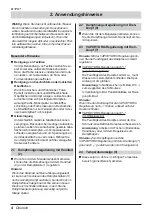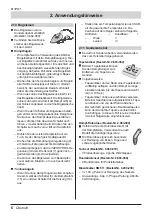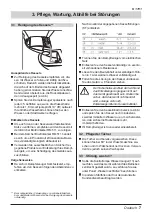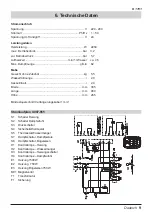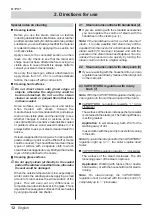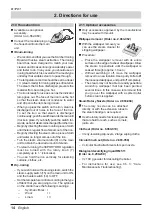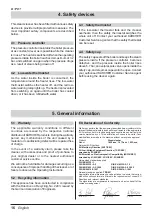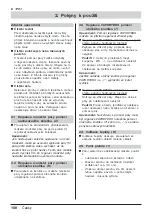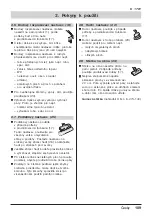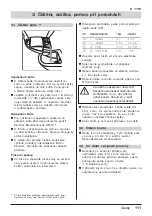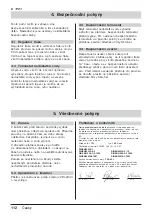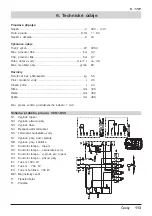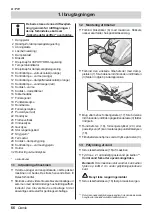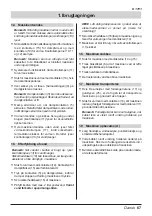
12
English
K 1701
2. Directions for use
Special notes on cleaning
•••••
Cleaning textiles
Before you use the steam cleaner on textiles
including delicate fabrics like Dralon, velvet, leather
and items protected by Scotch Guard or any similar
substance, you should always test that the material
is resistant to steam by applying it to a section not
normally visible.
Apply steam to the concealed section and then
leave it to dry. Check to see that the colour and
shape have not been affected before moving to a
visible area. In case of doubt it is always better to
consult your steam cleaner dealer.
Use only the steam gun without attachments to
apply steam from 30 - 45 cm on these delicate
fabrics, then wipe off with a cotton cloth.
•••••
Cleaning hard surfaces
Do not direct steam onto glued edges of
objects, otherwise the edge strip could be
become detached. Do not use the steam
cleaner on wood or parquet floors that have
not been sealed.
Some surfaces can change colour and texture
when treated with steam. Consult the
manufacturers recommendations first, and always
test in a non visible place and then let it dry, to see
whether changes in colour or textures occur. In
case of doubt and on sensitive materials like coated
or painted surfaces, wood, waxed marble etc. it is
always better to ask your steam cleaner dealer for
advice.
If steam is applied for too long, wax, furniture polish,
plastic coating or paint could be lifted off or marks
could be caused. You should therefore clean these
types of surface with a separate cloth to which
steam has been applied or very briefly with a double
layer of cloth attached to the nozzle.
•••••
Cleaning glass surfaces
Do not apply steam jet directly to the sealed
parts of the window round the frame, otherwise
the seal could be damaged.
When the outside temperature is low, especially in
winter, warm the window pane by applying a small
amount of steam across the whole surface of the
glass. This will even out any differences in
temperature and avoid stresses in the glass. This is
important because glass surfaces that are heated
by varying amounts can shatter.
2.1
Steam volume control with handwheel (2)
•••••
If you are working with the standard accessories
you can regulate the volume of steam with the
handwheel on the steam gun (1).
Note: If the handwheel is set for a small volume of
steam, it is quite possible that steam may still be
expelled from the nozzle for a short interval after the
steam switch (5) has been released and until the
pressure in the steam hose has dissipated. You can
release the pressure more quickly by turning the
steam volume control to a higher setting.
2.2
Steam volume control with rotary knob (9)
•••••
If you are working with the household iron you can
regulate the steam flow by means of the rotary knob
on the main unit.
2.3 VAPOHYDRO regulation with rotary
knob (7)
Note: With the VAPOHYDRO regulation facility you
can regulate on the unit the wetness of the steam.
•••••
VAPOHYDRO regulation towards “+” (anti-
clockwise)
The wetness of the steam increases the more water
is contained in the steam jet. The flushing efficiency
is at the greatest.
Application: In wet areas (e.g. bath, WC) for the
washing away of dirt.
In association with the pencil jet nozzle for cleaning
in the bath.
Note: If you turn the rotary knob for the VAPOHYDRO
regulation right up to “+”, the boiler empties itself
faster.
•••••
VAPOHYDRO regulation towards “–” (clockwise)
The wetness of the steam decreases. The dirt-
loosening power of the steam improves.
Application: Working with fabrics (floor nozzle,
hand nozzle), or with the household iron for steam-
ironing.
Note: For steam-ironing, the VAPOHYDRO
regulation must be turned with the rotary knob (7)
completely up to “–” (clockwise).
Содержание VAPORAPID 1701
Страница 3: ......






